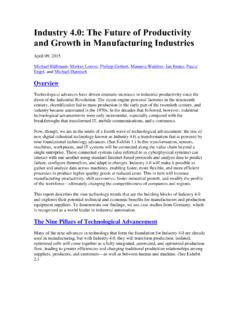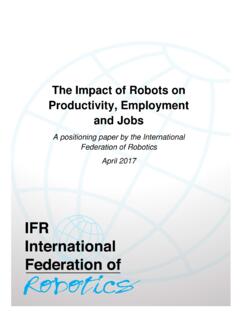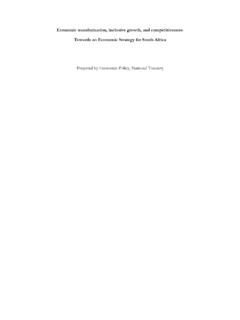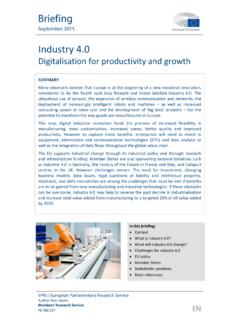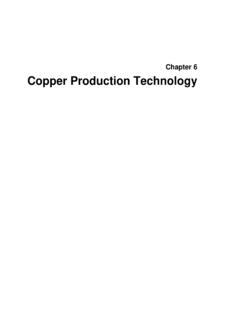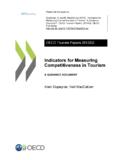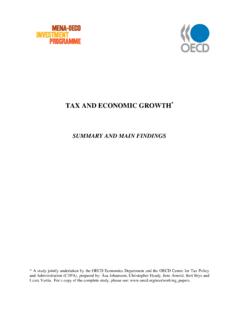Transcription of MATERIAL RESOURCES, PRODUCTIVITY AND THE …
1 MATERIAL RESOURCES, PRODUCTIVITY AND THE ENVIRONMENT:KEY FINDINGS 1 MATERIAL Resources, PRODUCTIVITY and the Environment Key Findings 1. Establishing a resource efficient economy is central to greening growth Natural resources are fundamental to the economy and human well-being Natural resources provide essential inputs to production (Table 1). Apart from production, the extraction, processing and ultimate disposal of materials are an important source of income and jobs in many countries. These activities also impact the environment to a greater or lesser extent. Natural resources are also part of the ecosystems that support the provision of services such as climate regulation, flood control, natural habitats, amenities and cultural services that are necessary to develop man-made, human and social capital.
2 The use of materials from natural resources in production and consumption processes has many environmental, economic and social consequences that extend beyond borders and affect future generations. They have consequences on: The rates of extraction and depletion of renewable and non-renewable natural resource stocks, and the extent of harvest and natural PRODUCTIVITY of renewable resource stocks. The environmental pressures associated with the extraction, processing, transport, use and disposal of materials ( pollution, waste, habitat disruption); and their effects on environmental quality ( air, climate, water, soil, biodiversity, landscape) and ecosystem services and human health. International trade and market prices of raw materials and other goods, and the PRODUCTIVITY and competitiveness of the economy.
3 The way natural resources and materials are managed through their life-cycle affects all of these activities. Table 1. Economic and environmental significance of selected materials and products Selected MATERIAL /Product Environmental Significance Economic Significance Aluminium Lightweight (transportation fuel efficiency) Infinitely recyclable Energy intensive production (GHG emissions) Solid waste (red mud) Widely used esp. in transportation, construction, electricity generation Increasing global demand Price volatility Consumption strongly coupled with economic growth Copper Infinitely recyclable Energy-intensive production E-waste Widely used esp. in electrical transmission and construction Increasing global demand Price volatility Iron and Steel Infinitely recyclable well-developed scrap markets Energy-intensive production Most widely used and traded metal in the world Increasing global demand Price volatility Rare Earth Elements Used in clean energy and energy efficiency technologies Recycling extremely challenging Chemically-intensive processing E-waste Used in wide range of high-tech electronics Lack of substitutes Increasing global demand, recent supply chain issues Price volatility Phosphorus Eutrophication Waste (phosphogypsum) and emissions (fluorine) Recyclable (with losses)
4 Food security Supports agricultural production Paper Renewable / recyclable (with losses) Carbon sequestration, habitat (forests) Potential source of energy (wood biomass) Energy- and water-intensive production Demand growing esp. in emerging economies Wide variety of products 2 Domestic extraction used (DEU) measures the flow of materials that originate from the environment and enter the economy to be transformed into or incorporated in products. Domestic MATERIAL consumption (DMC) provides a measure of the amount of materials directly consumed by economic activities within a country. DMC equals DEU plus imports minus exports. Current trends in MATERIAL demands present environmental and economic.
5 And create opportunities for new markets and greener growth The last decades have witnessed unprecedented growth in demands for raw materials worldwide, driven in particular by the rapid industrialisation of emerging economies and continued high levels of MATERIAL consumption in developed countries. International commodity markets have expanded, with increasing mobility of production factors and closer linkages among countries and regions. This has been accompanied by highly volatile commodity prices and growing competition for some raw materials. By 2050, the world economy is expected to quadruple and the global population to grow from 7 billion today to over billion. The OECD Environmental Outlook to 2050 shows the additional strain that this will place on the earth s MATERIAL and energy resources and the environment.
6 A growing population with higher average income requires more food, more industrial products, more energy and more water. This creates formidable challenges for sustainable economic and environmental development. Confronting the scale of these challenges requires ambitious policies to stimulate a significant increase in resource efficiency, particularly through technical change and innovation. The drive for improved resource efficiency will create new products, markets and employment opportunities. Establishing a resource efficient economy is central to green growth. It requires putting in place policies to improve resource PRODUCTIVITY and sustainably manage natural resources and materials, building on the principle of Reduce, Reuse and Recycle (the 3Rs).
7 To be successful, such policies need to be founded on a good knowledge base of the MATERIAL basis of the economy, international and national MATERIAL flows, and the factors that drive changes in natural resource use and MATERIAL PRODUCTIVITY over time, across countries and in the different sectors of the economy. Did you OECD countries account for: a third of all MATERIAL resources consumed worldwide; over two-thirds of wood harvesting; nearly half of global exports of raw, semi-finished and finished materials. 2. Worldwide use of MATERIAL resources has been increasing steadily Global trends Global extraction of MATERIAL resources continues to grow The amount of materials extracted, harvested and consumed worldwide increased by 60% since 1980, reaching nearly 62 billion metric tonnes (Gt) per year in 2008 (Figure 1), some 8-fold increase since the early 1900s.
8 OECD countries accounted for 38% of domestic extraction of used materials (DEU) worldwide in 2008, while the BRIICS (Brazil, Russia, India, Indonesia, China and South Africa) accounted for 35%.1 While more updated global figures are not yet available, MATERIAL use likely remains around 62 Gt today and is projected to reach 100 Gt by Growth has been primarily driven by increased global demand for construction minerals, biomass for food and feed, fossil energy carriers. These three MATERIAL groups account for 80% of total global MATERIAL extraction. 3 Figure 1. Global MATERIAL resource extraction Source: SERI (Sustainable Europe Resource Institute) MATERIAL flows database.
9 Materials originating from non-renewable natural resource stocks progressively dominate the MATERIAL mix Over the last century, resource extraction from non-renewable stocks has grown while extraction from renewable stocks has declined, reflecting the shift in the global economy base from agriculture to industry. Once accounting for some 75% of global MATERIAL extraction, biomass today accounts for less than a third of total extraction. Non-renewable resource extraction now represents over two-thirds of global MATERIAL extraction with construction minerals making up over 30% of global DEU in 2008, fossil energy carriers 20%, and metal and metal ores 13%. Industrial minerals account for around 2% of global extraction.
10 Although global MATERIAL use has been increasing steadily overall, growth has varied across MATERIAL groups. Metals Over the last 30 years, the strongest growth in raw MATERIAL demand has been for metal ores. Global metal extraction more than doubled between 1980 and 2008, rising from to Gt or by 133%, a rate on par with global economic growth. But growth has not followed a steady upward trajectory: after declining in the early 1990s, the growth in metal extraction witnessed a significant upswing from around 2002. This acceleration was due to high demands from countries entering their energy- and MATERIAL -intensive development phase, coupled with high levels of consumption in developed economies.










